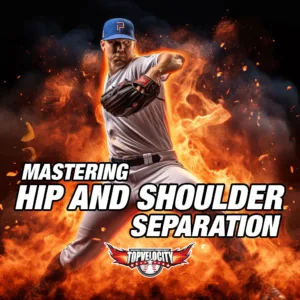 In the fascinating world of pitching mechanics, there's a crucial element that often separates elite pitchers from the rest: Hip and Shoulder Separation. This concept is pivotal for anyone looking to elevate their game, reduce injury risk, and maximize velocity. I’m Brent Pourciau, CEO of TopVelocity.net, and I have studied this subject in-depth, both as a professional pitcher and as someone deeply involved in kinesiology and sports science. Today, we're going to dissect what Hip and Shoulder Separation means and how it can radically change your pitching game.
In the fascinating world of pitching mechanics, there's a crucial element that often separates elite pitchers from the rest: Hip and Shoulder Separation. This concept is pivotal for anyone looking to elevate their game, reduce injury risk, and maximize velocity. I’m Brent Pourciau, CEO of TopVelocity.net, and I have studied this subject in-depth, both as a professional pitcher and as someone deeply involved in kinesiology and sports science. Today, we're going to dissect what Hip and Shoulder Separation means and how it can radically change your pitching game.
Many people know Tom House for revolutionizing pitching mechanics, but one of his major contributions was educating us about the ability to separate the hips and shoulders during the pitching motion. After recovering from a career-threatening rotator cuff surgery, I embraced this concept as part of my 3X Pitching Velocity Program. Ground-breaking studies in the last decade have further cemented its importance. Hip and Shoulder Separation is not just about speed; it also contributes to better health and efficiency in pitchers by optimizing the kinetic chain.
Understanding the Concept from a Lower-Half to Upper-Half Perspective
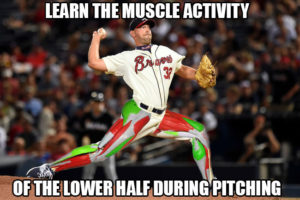 At TopVelocity, we delve into Hip and Shoulder Separation with a unique approach, focusing on the transition from the lower half of the body to the upper half. This begins with understanding the kinetic chain, which is much like a whip.
At TopVelocity, we delve into Hip and Shoulder Separation with a unique approach, focusing on the transition from the lower half of the body to the upper half. This begins with understanding the kinetic chain, which is much like a whip.
- Handle of the Whip (Hips and Legs): The handle of the whip symbolizes your hips and legs. Your legs generate the initial force, much like when you initiate a whip's movement by swinging its handle.
- Body of the Whip (Trunk): The core part of the whip represents your trunk, where most of the energy is transferred and amplified.
- End of the Whip (Arm): Your arm is the tip of the whip, where the energy culminates to generate maximum velocity.
Importance of Timing and Coordination
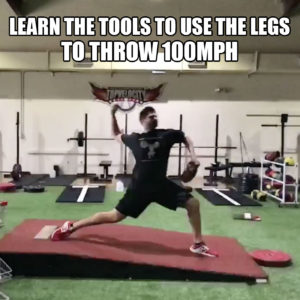 One of the most critical elements that often goes overlooked in mastering Hip and Shoulder Separation is the concept of timing and coordination. Let's break it down with scientific evidence to back it up.
One of the most critical elements that often goes overlooked in mastering Hip and Shoulder Separation is the concept of timing and coordination. Let's break it down with scientific evidence to back it up.
The Science Behind the Timing
Extensive research has shown a strong correlation between timing, hip and shoulder separation, and pitch velocity. Specifically, studies have indicated that high-velocity pitchers consistently exhibit a larger margin of time between the peak speed of their hips and the peak speed of their shoulders during the pitching motion. This temporal separation, often measured in milliseconds, may not seem like much to the naked eye, but it has profound implications for performance and arm health.
The Kinetic Chain: A Symphony of Movement
The human body operates as a kinetic chain when pitching. Each segment of the body, from the legs to the hips, to the trunk, and finally to the arm, contributes to the overall motion. A delay or 'separation' between the peak speeds of the hips and shoulders allows each segment to optimally contribute to the kinetic chain. When the timing is right, you achieve what's known as "segmental summation" — where each part adds its bit of energy efficiently to the final output. This harmonious coordination of body segments is akin to a well-conducted symphony, where each instrument plays its part at the right time for a beautiful end result.
Reducing Arm Stress
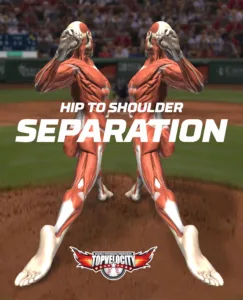 What's even more remarkable is that proper timing and increased hip to shoulder separation not only contribute to higher velocities but also to reduced arm stress. When the hips and shoulders are well-timed, the arm doesn't have to 'catch up' or compensate for a lack of power generated by the lower body. This decreases the stress placed on the arm, specifically the ulnar collateral ligament and the rotator cuff, thereby reducing the risk of injury over time.
What's even more remarkable is that proper timing and increased hip to shoulder separation not only contribute to higher velocities but also to reduced arm stress. When the hips and shoulders are well-timed, the arm doesn't have to 'catch up' or compensate for a lack of power generated by the lower body. This decreases the stress placed on the arm, specifically the ulnar collateral ligament and the rotator cuff, thereby reducing the risk of injury over time.
Timing as a Skill
Mastering the timing between your hips and shoulders is a skill that requires dedicated practice, often involving high-tech tools like 4D motion sensors to measure the exact timings down to the millisecond. Understanding this timing goes beyond mere practice; it delves into the biomechanics of your unique body, requiring a scientific approach to identify and correct any inefficiencies.
The Role of Coordination
Coordination here refers to the synchronicity between different muscle groups involved in the pitching action. Proper coordination ensures that the energy generated by the leg drive and hip rotation is effectively transferred up the kinetic chain, allowing the arm to ride this wave of energy instead of generating power independently. This harmonizes the entire process, creating a fluid and efficient pitching motion.
Mastering Hip and Shoulder Separation with 3X Med Ball Drills
 The Setup
The Setup
The 3X Med Ball Separation Full Stride Drill is designed to be the next step after you've mastered the arm path through preliminary drills like the bounce drill. To start this exercise, you'll want to assume a full stride position, at about 89% of your height. Place power pads beneath your feet if you're using a plate, aligned from heel to toe, angled approximately 20 degrees. This sets the stage for optimized hip and shoulder separation.
Initial Positioning: Hips and Shoulders
The main objective here is to open the hips fully while keeping the shoulders closed. If you find yourself limited in thoracic rotation or hip extension, it may be necessary to close the hips slightly. However, the primary goal is to keep your shoulders in a closed orientation, possibly even slightly counter-rotated. This creates necessary tension between the back hip and back shoulder, which is crucial for effectively utilizing the kinetic chain.
Elbow and Hand Position
Your elbows should be raised to shoulder height, starting at zero degrees of internal rotation. As you proceed through the drill, one hand supports one side of the med ball, and the other hand supports the opposite side. Ensure the ball is placed away from your head; if it's too close, you'll likely push the ball instead of properly engaging the trunk.
 Execution: Lift, Fall, and Drive
Execution: Lift, Fall, and Drive
From your starting position, initiate a lift and fall movement with your front leg. As you do this, focus on maintaining tension between your open hips and closed shoulders. You'll then drive down, entering the "cocking" stage just before initiating shoulder rotation. It's essential to achieve full cocking of the arm before shoulder rotation to ensure maximum energy transfer from the trunk to the ball.
Timing and Coordination
One of the keys to this drill is the mirroring action between the front and back parts of your body. While one side is pushing forward, the other should be pulling back, like two gears working in tandem. This optimizes the separation between the hips and shoulders, teaching your body to maintain this separation as you progress through the pitching motion.
Advanced Variations
Once you've mastered the basic form, you can start adding more power by kicking back the front leg as your trunk carries forward. This further amplifies the energy driving into the ball, reducing the workload on your arm.
The End Goal
The ultimate objective of the 3X Med Ball Separation Full Stride Drill is to instill in you the correct mechanics for hip and shoulder separation. This allows you to tap into the power of your trunk, directing more energy into the ball while minimizing the stress on your arm.
Takeaways
- Preparation: Proper stance and alignment are critical.
- Mechanics: Pay close attention to hip and shoulder positioning, as well as arm path.
- Execution: Timing and coordination are vital for effective separation and energy transfer.
- Advanced Techniques: Once basic mastery is achieved, extra leg power can be added for an additional boost.
By incorporating the 3X Med Ball Separation Full Stride Drill into your training regimen, you're not just improving your current skill set—you're laying the foundation for more advanced techniques. And remember, if you're serious about taking your pitching to an elite level, consider joining us at TopVelocity for more in-depth training and coaching.
Elevate Your Game with TopVelocity's Specialized 3X Training on Patreon Pro
 Are You Ready to Master Hip and Shoulder Separation?
Are You Ready to Master Hip and Shoulder Separation?
If you're serious about taking your pitching skills to the next level, then it's time to get the specialized training and coaching that only TopVelocity can offer. By signing up for our Patreon Pro membership, you gain exclusive access to remote coaching sessions, weekly video analysis, and specialized 3X training programs tailored just for you.
Why Choose TopVelocity Patreon Pro?
- Remote Coaching: Get personalized advice and guidance from experts who know the game inside and out.
- Weekly Video Analysis: Gain invaluable insights into your pitching mechanics, and receive actionable feedback to improve your game continuously.
- Specialized 3X Training: Experience our proven methods for mastering Hip and Shoulder Separation, a crucial component for achieving high-velocity pitching while minimizing the risk of injury.
- Evidence-Based Practice: Our programs are backed by scientific research and extensive field testing, ensuring that you're getting the most effective training available.
Elevate Your Game, Reduce Your Risks
Become the pitcher you've always aspired to be. Our comprehensive approach to training ensures not just improved performance but also reduced risk of injury. So, why wait? The time to act is now. Unleash your full potential with TopVelocity's evidence-backed, specialized 3X training programs.
Ready to Step Up to the Mound?
Click below to join the TopVelocity Patreon Pro community today and start your journey towards elite-level pitching.
Sign Up for TopVelocity Patreon Pro
Don't miss out on this opportunity to accelerate your growth and attain pitching excellence. With TopVelocity, you're not just a player; you're a game-changer.
Frequently Asked Questions on Mastering Hip and Shoulder Separation for Pitchers
- What is Hip and Shoulder Separation and why is it important for pitchers? Hip and Shoulder Separation is the technique where a pitcher delays the rotation of the shoulders while rapidly rotating the hips. This separation is critical for generating maximum velocity, enhancing energy transfer up the kinetic chain, and reducing stress on the arm.
- What scientific evidence supports the benefits of Hip and Shoulder Separation? Numerous studies have shown that high-velocity pitchers often have a greater time margin between the peak speeds of their hip and shoulder rotations. This allows for more efficient energy transfer, contributing to higher pitch speeds and reduced risk of injury.
- What are 3X Med Ball Drills and how do they help in achieving Hip and Shoulder Separation? 3X Med Ball Drills are specialized exercises designed to train the timing and coordination needed for effective Hip and Shoulder Separation. These drills involve a set of movements that teach the pitcher to maintain tension between the back hip and back shoulder, helping to use the kinetic chain more effectively.
- Are there any prerequisites before implementing the 3X Med Ball Drills? Before starting with the 3X Med Ball Drills, it's important to have your arm path down, which can be achieved through preliminary exercises like the bounce drill. The 3X Med Ball Drills then help you progress from this foundational knowledge.
- Is the TopVelocity Patreon Pro a good platform for mastering Hip and Shoulder Separation? Absolutely. The TopVelocity Patreon Pro offers remote coaching, weekly video analysis, and specialized 3X training. It is designed to provide evidence-based practices that help you become the pitcher you've always aspired to be.
- Can mastering Hip and Shoulder Separation help in injury prevention? Yes, one of the major benefits of mastering this technique is reducing stress on the arm, which can lead to a lower risk of injuries such as rotator cuff tears or elbow issues.
By taking the time to learn and master Hip and Shoulder Separation, you're not just potentially increasing your pitch velocity; you're also making a long-term investment in your athletic health.


 The Setup
The Setup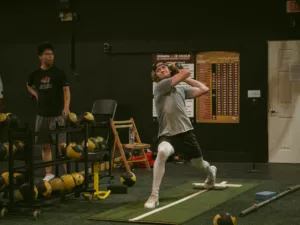 Execution: Lift, Fall, and Drive
Execution: Lift, Fall, and Drive Are You Ready to Master Hip and Shoulder Separation?
Are You Ready to Master Hip and Shoulder Separation?

